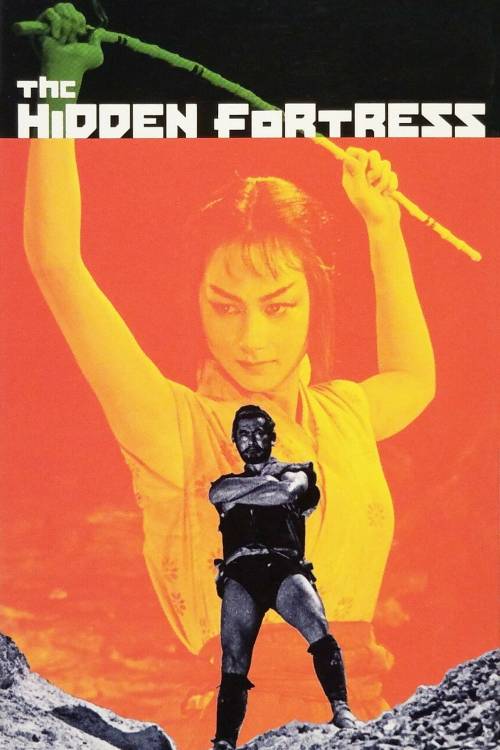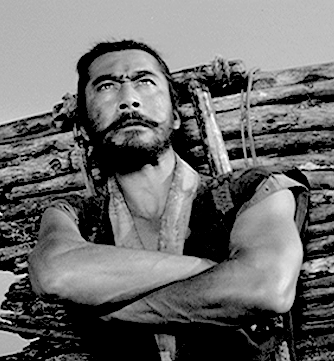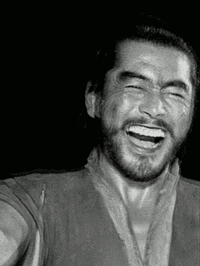Toshiro Mifune @ 100: The Hidden Fortress
 Monday, March 30, 2020 at 1:17PM
Monday, March 30, 2020 at 1:17PM Team Experience is celebrating the Centennial of Japan's great movie star Toshiro Mifune for the next few days. Here's Nathaniel R...


Raised as an American child (through no fault of my own) in the era when the original Star Wars trilogy first captured the world's hearts, it's perhaps unsurprising that I knew Star Wars before any of its influences. Though my innate interest in cinema led me eventually to "Akira Kurosawa's greatest hits" somehow The Hidden Fortress (1958), always escaped my eyes. I knew of it mainly only as 'that movie that everyone says inspired George Lucas's space opera.'
It would be foolish to pretend with snobbish cinephilia that the original Star Wars film doesn't improve on its then 19 year-old inspiration, but The Hidden Fortress deserves more than this footnote status; minor Kurosawa is still Kurosawa...
You can blame this reserved praise on the first 20 minutes of this adventure which strands us in media res in the misadventures of Tahei and Matashichi (Minoru Chiaki and Kamatari Fujiwara). It's more than enough time to become very annoyed with them and they'll be with us for the entire running time. In the Star Wars saga they'd become the forever-bickering C3PO and R2D2, often merely along for the grand ride, but sadly here they are both as talkative as C3PO, only considerably stupider and shriller.


These two bumbling greedy peasants had planned to hire themselves out as soldiers but have arrived after the battle and been immediately mistaken for members of the side that lost. The early sequences are elaborate if overkill scene-setting but they give Kurosawa a grand opportunity to stage scenes of mass dangerous chaos and kinetic movement. The Hidden Fortress was his first picture shot in Tohoscope (Japan's answer to CinemaScope) and the Japanese master fills up the expanded frame as well as one might predict.
The picture picks up considerably upon the stealth arrival of General Rokurota Makabe (Toshiro Mifune) who appears first in a sly longshot, behind the foreground buffoonery, arms akimbo and already in judgment of the greedy duo.
 Given Mifune's typically bold strokes acting -- Kurosawa, by his own admission was rarely impressed by actors (you can see that he favors broad performance styles) -- we're left forever wondering if he is going to kill the peasants or finds them amusing enough for companionship. Or possibly both. First one then the other? That tension works for the picture.
Given Mifune's typically bold strokes acting -- Kurosawa, by his own admission was rarely impressed by actors (you can see that he favors broad performance styles) -- we're left forever wondering if he is going to kill the peasants or finds them amusing enough for companionship. Or possibly both. First one then the other? That tension works for the picture.
Mifune arrives none too soon for waning interests, though even his formidable screen presence isn't enough to keep Hidden Fortress particularly exciting for the first hour. However once the team is in place, a now kingdom-less Princess Yuki (Misa Uehara) in tow, the movie takes off with kinetic adventure, charged team dynamics, and tense action; the back half of the picture is twice the movie!
While you can see a few techniques and shots that George Lucas lifted wholesale, The Hidden Fortress as a template for Star Wars (1977) has been arguably overstated due to the space saga's cultural ubiquity. Mifune's loyal formidable general may be the Princesses's last hope, like a more virile and more easily amused Obi-Wan, but the picture is absent a Luke or Han.
That's okay, since Mifune can fill a wide wide screen like he's more than one actor. That's true whether he's wielding sticks (there are a lot of sticks in this picture (sticks with gold inside them!), swords (Mifune tearing across a blurry screen like a retro anime figure in motion is quite something), spears (watch out for a well-choreographed battle with a rival general), or merely his wits.

And speaking of wits.
In one memorable sequence this rebel alliance evades capture by walking right into the enemy ranks and drawing attention to themselves. General Makabe practically reveals them only to twist the reveal and play the part that we've previously associated with those comic bumbling fools, an opportunist demaning a handout for his low effort information.
He makes an obstinate scene.


The Princess looks on with dazzled admiration, surely mirroring the audience's emotions. She's marvelling at her General's tactical gifts which she's surely never seen in action before. But even if you have seen Mifune in action before -- and he's so good in action -- you're no less appreciative of the movie star's gifts.
Despite a patience-testing first hour, The Hidden Fortress is one of those rare pictures that improves with each new chapter, rather than deflating after early thrills. Each new character introduced after the peasants (General - Princess - Slave Girl - Rival General) adds immeasurably to the plot and excitement. It's a backloaded marvel saving nearly all its best scenes for the last hour.
By the time we reached its brief coda finale, a lighthearted awards ceremony (that Star Wars also lifted), you'll want to hand it prizes, too. Or at least bow deeply to its General and Princess, two memorably stubborn noble characters that would inspire audiences and future filmmakers, too.

Previously:
Lynn Lee on Stray Dog (1949)



Reader Comments (3)
I don't think of The Hidden Fortress as a minor Kurosawa film but a top-tier one though not as revered as The Seventh Samurai, Ikiru, Ran, Yojimbo, High & Low, or Rashomon. A minor Kurosawa film for me would be something like Dodesukaden though a minor Kurosawa film is still better than a lot of other films.
It's been a while since seeing it last, but I always thought this was one of Kurosawa's most purely entertaining films.
Jonathan -- it's definitely entertaining.... but so lopsided.